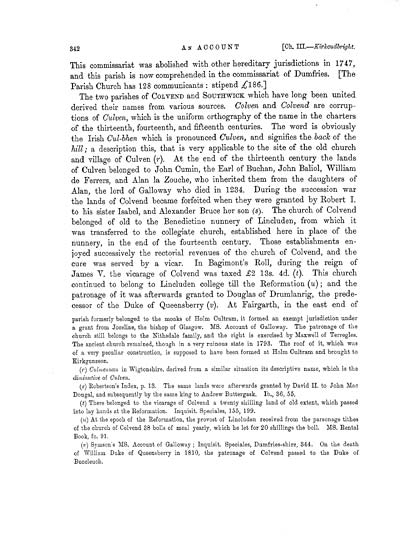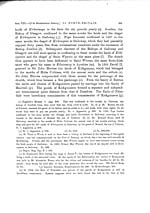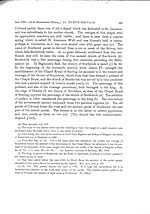Volume 5
(349) Page 342
Download files
Individual page:
Thumbnail gallery: Grid view | List view

342 This commissariat was abolished with other hereditary jurisdictions in 1747, and this parish is now comprehended in the commissariat of Dumfries. [The Parish Church has 128 communicants : stipend �l86.] The two parishes of COLVEND and SOUTHWICK which have long been united derived their names from various sources. Colven and Colvend are corrup- tions of Culven, which is the uniform orthography of the name in the charters of the thirteenth, fourteenth, and fifteenth centuries. The word is obviously the Irish Cul-bhen which is pronounced Culven, and signifies the back of the hill; a description this, that is very applicable to the site of the old church and village of Culven (r). At the end of the thirteenth century the lands of Culven belonged to John Cumin, the Earl of Buchan, John Baliol, William de Ferrers, and Alan la Zouche, who inherited them from the daughters of Alan, the lord of Galloway who died in 1234. During the succession war the lands of Colvend became forfeited when they were granted by Robert I. to his sister Isabel, and Alexander Bruce her son (s). The church of Colvend belonged of old to the Benedictine nunnery of Lincluden, from which it was transferred to the collegiate church, established here in place of the nunnery, in the end of the fourteenth century. Those establishments en- joyed successively the rectorial revenues of the church of Colvend, and the cure was served by a vicar. In Bagimont's Roll, during the reign of James Y. the vicarage of Colvend was taxed �2 13s. 4d. (t). This church continued to belong to Lincluden college till the Reformation (u); and the patronage of it was afterwards granted to Douglas of Drumlanrig, the prede- cessor of the Duke of Queensberry (v). At Fairgarth, in the east end of parish formerly belonged to the monks of Holm Cultram, it formed an exempt jurisdiction under a grant from Joceline, the bishop of Glasgow. MS. Account of Galloway. The patronage of the church still belongs to the Nithsdale family, and the right is exercised by Maxwell of Terregles. The ancient church remained, though in a very ruinous state in 1793. The roof of it, which was of a very peculiar construction, is supposed to have been formed at Holm Cultram and brought to Kirkgunzeon. (r) Culmennan in Wigtonshire, derived from a similar situation its descriptive name, which is the diminutive of Culven. (s) Robertson's Index, p. 13. The same lands were afterwards granted by David II. to John Mac Dougal, and subsequently by the same king to Andrew Buttergask. Ib., 36, 55. (t) There belonged to the vicarage of Colvend a twenty shilling land of old extent, which passed into lay hands at the Reformation. Inquisit. Speciales, 155, 199. (u) At the epoch of the Reformation, the provost of Lincluden received from the parsonage tithes of the church of Colvend 38 bolls of meal yearly, which he let for 20 shillings the boll. MS. Rental Book, fo. 91. (v) Symson's MS. Account of Galloway ; Inquisit. Speciales, Dumfries-shire, 344. On the death of "William Duke of Queensberry in 1810, the patronage of Colvend passed to the Duke of Buccleuch.
Set display mode to:
![]() Universal Viewer |
Universal Viewer | ![]() Mirador |
Large image | Transcription
Mirador |
Large image | Transcription
Images and transcriptions on this page, including medium image downloads, may be used under the Creative Commons Attribution 4.0 International Licence unless otherwise stated. ![]()
| Caledonia, or, An account, historical and topographic of North Britain from the most ancient to the present times > Volume 5 > (349) Page 342 |
|---|
| Permanent URL | https://digital.nls.uk/74530822 |
|---|---|
| Description | Vol. V. |
|---|---|
| Attribution and copyright: |
|

